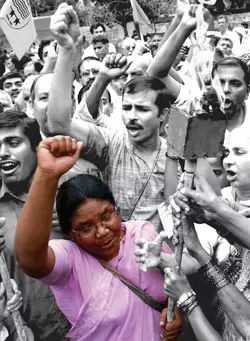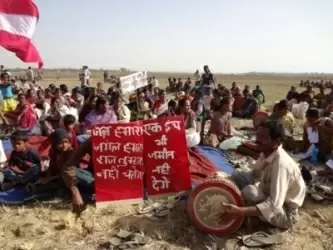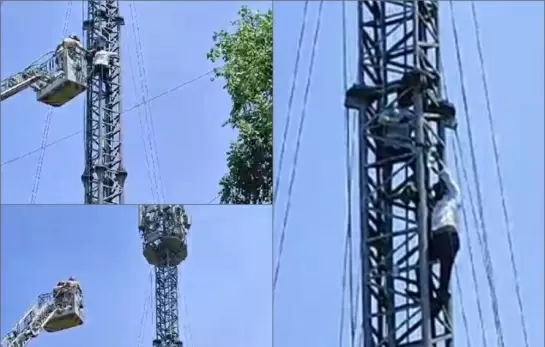A conflict over 227acres of land adds to tribal discontentment in Jharkhand
11-January-2013
Vol 4 | Issue 2
‘We will fight and we will win’, the emphatic slogan of fiery activist Dayamani Barla resounds once again in the tribal state of Jharkhand. Jharkhand is in the throes of a long-drawn-out anti-displacement battle between the state government and its adivasi farmers.
This time, the epicentre is in Nagri, roughly 15 km from the capital city of Ranchi. The conflict is over 227 acres of land allotted by the government for the building of campuses for the Indian Institute of Management (IIM), Indian Institute of Information Technology (IIIT) and National University of Study and Research in Law (NUSRL).
 |
|
Dayamani Barla leading a protest (Photo courtesy: Tehelka)
|
Caught in the crossfire are 128 affected families that claim to be the lawful owners of this fertile stretch of land that has sustained them for generations. (The number of displaced families till date has increased to about 500.)
They question how the government could have acquired the land in the first place when neither they nor their forefathers had agreed to sell it. The families say they turned down compensation offered to them by the government in lieu of the land. They also say that the government should allot alternative sites for the proposed universities instead of trying to usurp agricultural lands.
The agitation has generated widespread support from adivasi communities across the state. Dayamani Barla, who leads the agitation, has been lodged in Birsa Munda Central Jail, Ranchi, since October 16. Meanwhile, the government is carrying on its construction work amid deployment of members of the Rapid Action Force.
Ganeshwar Ram Munda, who has lost 5 acres, says: “Land is the only source of income for us here. Such forcible acquisition of land is like snatching away food from our mouths.”
Notwithstanding the dissenting tribal voices, the government claims ownership of the disputed land, saying that it had acquired it way back in 1957-58 to build an extension and a seed farm for the Birsa Agricultural University. However, a response to an RTI application filed by Barla reveals another story.
In 1957, the then unified Bihar government had acquired the land and in turn offered total compensation of Rs 155,147.88 to 153 families. Of these 153 families, only 25 accepted the compensation which was at the rate of Rs 2,700 per acre. The remaining families refused to part with their land and declined compensation. The money went back to the government treasury that same year, and since then the issue has been hanging in the balance. Incidentally, the value of the same land after nearly 50 years has shot up to Rs 1.5 crore per acre, increasing its total present worth to about Rs 350 crore.
The villagers of Nagri claim they have paid land revenue to the government till the month of February 2012. Sheila Toppo, who lost 12 acres of land, says: “The government is trying to involve us in technicalities. But we have enough documentary proof to claim that the land belongs to us.”
Deputy Commissioner, Ranchi, K K Soan refutes the claim saying: “The land revenue department did not receive any revenue money after 2007 and did not issue any receipts.” He further states that the land had been acquired by the government in 1957. “Just because 128 families refused to give away their land and did not take the compensation does not imply that the land was not acquired by the government.”
The Nagri residents’ petition asserting that the so-called land acquisition was not in line with legal provisions contradicts such claims by the district administration. It raises the basic question of how the government could acquire tribal land in Jharkhand under the Land Acquisition Act (1894) when the state was listed under the Fifth Schedule of the Constitution which is a historic guarantee to indigenous people to rights over land on which they reside.
In addition to this, the petition clarifies that even if the government had followed the provisions of Section 17 (4) of the Land Acquisition Act, 1894, where land is acquired in case of urgent public requirement, possession must be taken within hours or at least within months. In this case, more than 50 years have passed and the government had not taken possession of the land, clearly indicating that there was no such urgency.
Further, the villagers cite the Chotanagpur Tenancy (CNT) Act of 1908 which is in force in Jharkhand. Section 46 of the CNT Act restricts transfer of land belonging to scheduled tribes/scheduled castes and backward classes. The deputy commissioner refutes these contentions saying: “There are hundreds of acres of acquired land in the state where possession is yet to be taken.”
The situation took a turn for the worse for these Oraon adivasi farmers in May this year. Based on a PIL filed by the Bar Association of Ranchi, the high court, on April 30, ordered the government “to secure the construction of the buildings of the educational institutions within 48 hours”. This stirred up massive opposition, with three farmers -- Mundri Oraon, Dashmi Kirketta and Poko Tirke -- dying of a heatstroke whilst protesting under the blistering summer sun.
The government’s land acquisition claim was challenged by Nagri residents in the Supreme Court. But in June, the apex court turned down their special leave petition taking the plea that in the matter of land acquisition of 1956-57 it was not inclined to interfere with the orders of the high court.
Things came to a head when the government began constructing a boundary wall in July around the proposed campuses. Venting their ire, the residents demolished the wall leading to a scuffle between the police and villagers. Protesting villagers laid siege to the chief minister’s residence and Raj Bhavan to press their demands. When nothing happened they resorted to a hunger strike.
In September, the high court directed the state government to secure the university’s construction against obstruction by locals. The government has imposed Section 144 (IPC) in Nagri three times since July, prohibiting farmers from gathering on the farmland. Paramilitary forces have been stationed in the area.
The villagers did however recently harvest their standing winter crop, with officials from the district administration stationed at the site and RAF constables wielding rifles and teargas boxes. “We will reap this harvest and plough the land again to sow gram and mustard. If the government tries to stop us they should prepare for our response too,” said Vikas Toppo, who has emerged as one of the leaders of the Nagri Bachao Samiti.
The Nagri agitation continues to simmer despite Dayamani Barla being lodged in Birsa Munda Central Jail for over one-and-a-half months. Fondly addressed by her people as ‘Didi’, her apolitical front, the Adivasi Moolvaasi Asthtva Raksha Manch, is committed to protecting the existence and identity of the tribals.
In a letter to her supporters from jail, Barla reiterated her stand. “We will not part with an inch of our land. What is our fault? Why are we branded as criminals and imprisoned when we demand our rights? Are we not citizens of a democratic country? How can there be such a brazen violation of basic human rights,” she asked.
For Barla, who won an anti-displacement battle against world steel giant Arcelor Mittal, braving police lathis and the wrath of the district administration is routine. The Chingari award-winner and recipient of other recognitions for her fearless journalism and grassroots leadership, Barla has been leading the Nagri agitation since 2010 when the government formally allotted the land for construction of the various campuses.
 |
|
Agitation in Nagri (Photo courtesy: Infochange News & Features)
|
As if Barla’s arrest was not enough, the Jharkhand government continued arresting grassroots activists. Anti-mining activist Xavier Dias and five of his comrades were arrested on November 24. The arrests were made on the basis of a 21-year-old case for their alleged role in leading a protest against Tata’s iron ore mine in Noamundi, West Singbhum district.
Dias and his co-workers were granted bail on November 26. Ironically, when the state was formed, Dias was honoured by the government for his fight for tribal rights. He was also assured that all pending cases against him and his workers would be dropped.
“If we demand a MGNREGA card, they issue a property warrant. If we demand our land, water, forests, the Jharkhand government says we are a danger to the state. Is this the freedom leaders like Birsa Munda fought for,” asks Nelson Barla, Dayanani’s husband who runs a tea stall in Ranchi for a living. He admits that it is a mixed feeling of pride and agony to be the husband of such a vocal tribal rights activist as Dayamani Barla.
Meanwhile, support for the cause has poured in from various parts of the world. Social-activist-turned-politician Arvind Kejriwal, founder of the Aam Admi Party and leading the crusade for India Against Corruption (IAC), said: “We have extended moral and ideological support to tribal activist Dayamani Barla.”
He expressed concern at the way governments and establishments have been repressing public movements and people who dare raise their voices against them. American philosopher-activist Noam Chomsky too has written a letter to the Government of India demanding Barla’s release.
“We wanted a separate state hoping that tribals would enjoy equal rights. But the new governments failed to give the tribal population their rights,” says Salkhan Murmu, leader of the Jharkhand Dishom Party. The turn of events in Jharkhand indicates that strong grassroots leaders like Dayamani Barla are perceived as a threat to the so-called ‘development process’. - Infochange News & Features














